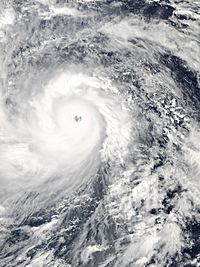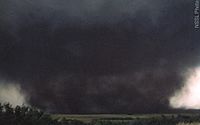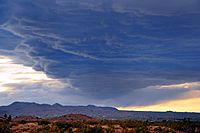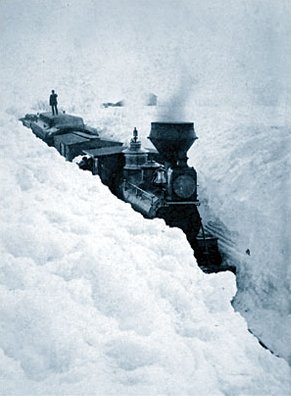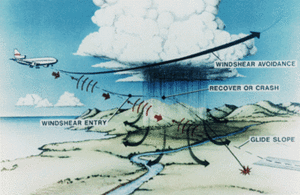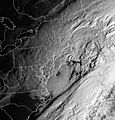Storm facts for kids

A storm is a type of violent weather. It usually brings heavy rain and strong wind. Sometimes, storms can also have thunder, lightning, or even ice.
Very strong storms like hurricanes, typhoons, and tornadoes have special names because they are so powerful. Scientists who study storms and weather are called meteorologists. Knowing about storms is very important, especially for ships at sea, to keep everyone safe.
Storms can have many different names depending on what they bring, like icestorms, blizzards, snowstorms, or firestorms. Thunderstorms often happen in hot, humid places like India. This is because warm air rises quickly, carrying water droplets high up. These droplets freeze and then fall, creating the lighting and sound we know as thunder.
Contents
Types of Storms
There are many kinds of storms, each with its own features:
- Blizzard – A blizzard is a severe snowstorm. It has strong winds, heavy snow (at least 5 centimeters or 2 inches per hour), and very cold temperatures.
- Bomb cyclone – This is a storm that gets very strong, very fast. It usually happens over the ocean. The winds can be as powerful as a hurricane.
- Coastal Storm – These storms bring large waves and high water levels to the coast. They can cause coastal erosion and coastal flooding.
- Derecho – A derecho is a long-lasting, straight-line wind storm. It is caused by a fast-moving group of strong thunderstorms over land.
- Dust devil – This is a small, spinning column of rising air that picks up dust.
- Dust storm – When strong winds pick up a lot of sand or soil, it creates a dust storm. This makes it very hard to see.
- Firestorm – A firestorm is a huge fire that becomes so intense it creates its own wind system. This can happen naturally in large wildfires or from powerful explosions.
- Gale – A gale is a strong wind, usually between 63–90 km/h (39–55 mph).
- Hailstorm – This storm drops round chunks of ice called hail. Most hail is small, but sometimes it can be larger than 5 cm (2 inches). Large hail can cause a lot of damage.
- Hypercane – This is a theoretical, super-strong tropical cyclone. It could form if ocean temperatures were extremely hot (over 50 °C or 122 °F). Such a storm would have winds over 800 km/h (500 mph).
- Ice storm – Ice storms are very dangerous winter storms. Rain falls and freezes instantly when it hits cold surfaces, creating a layer of ice. Even a small amount of ice can break power lines and tree branches. It also makes roads very slippery.
- Microburst – A microburst is a very strong, short burst of wind from a thunderstorm. It only lasts a few minutes.
- Ocean Storm or sea storm – These are strong storms out at sea with winds of 90 km/h (55 mph) or more. They can be dangerous for ships.
- Snowstorm – A snowstorm is a heavy fall of snow, usually more than 5 centimeters (2 inches) per hour. Snowstorms can cause power outages and make travel impossible.
- Squall – A squall is a sudden increase in wind speed, lasting at least one minute.
- Thunderstorm – This storm produces both lightning and thunder, along with heavy rain. They happen when warm, moist air rises quickly and creates powerful updrafts.
- Tornado – A tornado is a violent, spinning wind storm that happens on land. It looks like a dark, funnel-shaped cloud. Tornadoes are known as some of the most destructive storms.
- Tropical cyclone – This is a storm system that forms over warm ocean waters. It has a spinning center of low pressure. Depending on their strength and location, they are called tropical depressions, tropical storms, hurricanes, or typhoons.
- Wind storm – A wind storm is marked by very high winds with little or no rain. These winds can cause a lot of damage to buildings and other structures.
How Storms Affect People
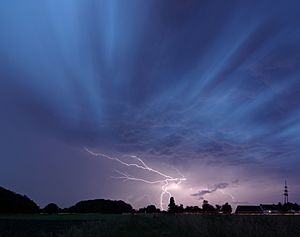
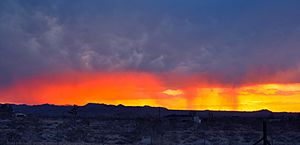
Strong winds from any type of storm can damage or destroy cars, buildings, and bridges. Loose objects can become dangerous flying pieces. For example, in the United States, very strong hurricanes cause most of the damage from tropical cyclones.
Tropical cyclones often cause power outages for many people. They can also destroy roads and bridges, making it hard to get food, water, and medicine to affected areas. The damage can also force people to leave their homes.
The storm surge is a big rise in sea level caused by a tropical cyclone. This is often the most dangerous part of these storms. It can flood homes miles inland and block escape routes. While destructive, storm surges also mix up coastal waters, which helps fish breeding areas.
Lightning and Wildfires
Lightning from thunderstorms can start wildfires. If there isn't much rain with the lightning, fires can spread quickly, especially if the land is dry. Wildfires can destroy plants and animals in an area. If they happen near towns, they can damage buildings and create risks of explosions. Lightning strikes can also directly harm people, especially those working outside.
Acid Rain
Lightning can also contribute to acid rain. This is rain with a low pH level, meaning it's more acidic than normal rain. Acid rain can damage buildings made of certain materials. In nature, it can harm plants and make water bodies and soil more acidic, which can kill fish and other organisms.
Hail Damage
Hail can cause serious damage to roofs, cars, and even aircraft. It's often hard to see hail damage on roofs until leaks or cracks appear. Hail can dent vehicles and crack or shatter windshields. Very rarely, large hailstones have caused serious injuries. The largest hailstone ever recorded in the United States fell in 2010 in South Dakota. It was about 20 cm (8 inches) wide and weighed almost 1 kg (1.93 lbs)!
Snowfall Effects
Heavy snowfall can disrupt daily life, even in places used to snow. Air and ground travel can stop completely. Basic services like electricity, telephone lines, and gas supply can fail. Roads become very hard to use, and vehicles can get stuck.
Sometimes, schools or workplaces close for a "snow day". In places that don't get much snow, even a small amount can cause closures because they are not prepared.
Snow is often removed from roads to make travel safer. This is done with shovels and snowplows, often with salt to melt the snow. In some snowy areas, like Japan, people store snow in ice houses to use for cooling in the summer, which saves electricity.
Agriculture and Snow
Hail can cause major damage to crops, especially wheat, corn, and soybeans. Snowfall can be good for farming. It acts like a blanket, keeping the ground warm and protecting crops from freezing temperatures. Many farms rely on snow melting in spring to water their crops. If snow melts and refreezes on delicate crops like oranges, the ice can actually protect the fruit from colder air.
Tropical cyclones, while destructive, can also bring much-needed rain to dry areas. For example, Japan gets over half of its rainfall from typhoons.
Aviation and Storms
Hail is a big danger to airplanes. Hailstones larger than 0.5 inches can seriously damage planes in seconds. Strong winds from thunderstorms, called wind shear, can also be very dangerous for aircraft. Wind shear can cause a plane to suddenly lose speed and lift, which can lead to accidents if the plane is too low to the ground. Because of past accidents, commercial airplanes now have systems to detect wind shear.
Recreation and Snow
Many winter sports depend on snow, such as skiing, snowboarding, snowmobiling, and snowshoeing. If there isn't enough natural snow, snow cannons can make it. Children and adults also enjoy playing on sleds. However, deep snow can make hiking dangerous by hiding landmarks and making the landscape look uniform.
Images for kids
-
A shelf cloud over the Swedish island of Öland in 2005.
-
Desert storms often have strong winds and pass quickly.
-
Lightning storm in Port-la-Nouvelle.
-
Satellite image of a strong nor'easter in 2006. Notice the hurricane-like eye.
-
Classic storm of summer, in Sierras de Córdoba, Argentina.
-
The Great Red Spot on Jupiter.
-
The Great Wave off Kanagawa, a famous print by Hokusai.
-
High Desert storm approaches at sunset.
-
Heavy storm brought by Severe Tropical Storm Sanvu in Hong Kong.
-
Winter North Atlantic storm with very high waves.
See also
 In Spanish: Tormenta para niños
In Spanish: Tormenta para niños



